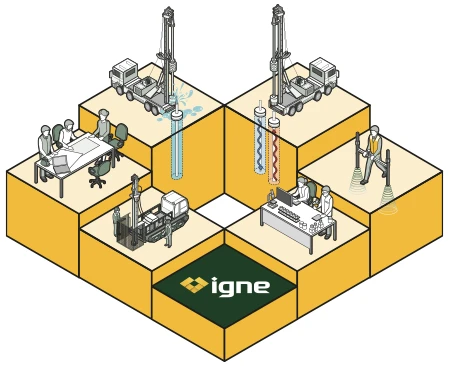

Ground Investigation Utility Avoidance Surveys
Ground Investigation Utility Avoidance Surveys are crucial for ensuring the safety and efficiency of construction projects, helping you avoid costly utility damage.
About
Why Choose Our Ground Investigation Utility Avoidance Surveys?
Ground investigation utility avoidance surveys are critical in site investigation to ensure that underground utilities, such as gas pipes, electricity cables, water mains, and telecommunications networks, are located and avoided during ground investigation activities like drilling, excavating, or piling.
These surveys are designed to map out the presence of utilities to prevent accidental damage, ensuring the safety of workers and avoiding costly project delays or repairs.
Utility strikes during ground investigations can have serious consequences, from safety hazards and project delays to financial and legal repercussions. A ground investigation utility avoidance survey provides the necessary data to minimise these risks by identifying and mapping underground utilities before any invasive groundworks begin.
This enables site teams to plan their activities with a full understanding of the subsurface conditions, thereby reducing the likelihood of damaging underground infrastructure.
These surveys utilise various detection methods, including electromagnetic locators (EML), ground-penetrating radar (GPR), and sometimes even visual inspections to accurately locate utilities without disturbing the ground. In doing so, ground investigation utility avoidance surveys serve as a vital risk management tool, ensuring that all site works proceed safely and efficiently.

Benefits
The Benefits of Ground Investigation Utility Avoidance Surveys
Commissioning ground investigation utility avoidance surveys is an essential step for any project that involves disturbing the ground, from small developments to large-scale infrastructure projects.
The reasons for commissioning these surveys go beyond compliance with health and safety regulations and are primarily driven by the need to protect your project from unforeseen complications and unnecessary expenses.
Prevent Utility Strikes
The primary reason for commissioning these surveys is to prevent utility strikes. Striking a gas pipeline, electrical cable, or water main during ground investigations can lead to significant project delays, safety hazards, and costly repairs. By identifying and mapping the location of utilities before work begins, you reduce the risk of accidents and ensure that your project proceeds without disruption.
Project Cost Control
Unexpected utility strikes can lead to unplanned expenses in the form of repairs, delays, and potential legal claims. Commissioning a ground investigation utility avoidance survey allows you to plan around these risks, minimising the likelihood of unexpected costs. Additionally, knowing the precise location of utilities enables more efficient project planning and resource management.
Optimise Ground Investigation Activities
Having a clear understanding of the location of utilities allows your team to optimise drilling, piling, and excavation activities. With precise mapping data in hand, project managers can avoid problematic areas, reducing the time spent on ground investigation and enabling the project to remain on schedule.
Ensure Site Safety
Utility avoidance surveys enhance the safety of your site workers by preventing accidental strikes on hazardous utilities such as high-voltage electrical cables or pressurised gas mains. Ensuring the safety of your workforce is paramount, and these surveys are a key tool in protecting against life-threatening incidents.
Improve Stakeholder Confidence
Commissioning a ground investigation utility avoidance survey demonstrates that you are taking the necessary steps to manage risks responsibly. Stakeholders, including investors, contractors, and local authorities, will be more confident in your project’s safety, efficiency, and adherence to industry best practices.
Process
How Ground Investigation Utility Avoidance Surveys are Designed, Planned, and Carried Out
Ground investigation utility avoidance surveys follow a structured process to ensure that all utilities are detected, mapped, and effectively avoided. At Igne, we use a combination of advanced technology and proven methodologies to deliver high-accuracy results that help safeguard your project.
Here’s a breakdown of how these surveys are designed, planned, and executed:
- Initial Site Assessment & Planning
Before any physical surveys begin, our team conducts an initial site assessment to gather existing records and information about known utilities in the area. This involves contacting utility providers to obtain plans, which gives us a broad understanding of the expected utility layout. This information is cross-referenced with the planned ground investigation activities to determine high-risk areas where utility avoidance is most critical. - On-Site Utility Detection
Once the planning phase is complete, our team deploys a combination of non-intrusive utility detection methods, such as electromagnetic locators (EML) and ground-penetrating radar (GPR). These tools allow us to detect utilities beneath the surface without disturbing the ground. EML is particularly useful for detecting metallic utilities such as water and gas pipes, while GPR can locate both metallic and non-metallic utilities like plastic water mains and fibre optic cables.
- Data Collection & Analysis
The utility data collected on-site is processed and analysed by our team of experts. We map out the precise location, depth, and alignment of the detected utilities and compile the information into a detailed report. This report will also highlight areas of concern where ground investigation activities may need to be adjusted to avoid utilities. - Utility Avoidance Recommendations
Based on the utility mapping data, we provide clear recommendations for utility avoidance during ground investigations. This may involve adjusting the location of boreholes, trenches, or test pits to minimise the risk of strikes. If necessary, we can also recommend safe zones for drilling or excavating that are free from utilities. - Ongoing Monitoring & Support
As ground investigations progress, new utilities may be installed, or existing conditions may change. Igne offers ongoing monitoring and support to ensure your team has access to the most up-to-date utility data. This helps maintain a safe and efficient working environment throughout the project lifecycle.
Learn More
Frequently Asked Questions about Ground Investigation Utility Avoidance Surveys
- What is a ground investigation utility avoidance survey?
A ground investigation utility avoidance survey is a type of survey designed to detect and map underground utilities to ensure that they are not accidentally struck during ground investigations such as drilling, piling, or excavating.
- Why are utility avoidance surveys important?
Utility avoidance surveys are crucial for preventing accidental strikes on underground utilities, which can cause significant safety risks, costly delays, and expensive repairs. These surveys help protect both the project and the workers involved by ensuring that utilities are identified and avoided.
- How are utilities detected in ground investigation utility avoidance surveys?
Utilities are typically detected using non-intrusive methods such as electromagnetic locators (EML) and ground-penetrating radar (GPR). These tools allow surveyors to identify the location and depth of utilities without disturbing the ground.
- What happens if a utility is struck during ground investigations?
If a utility is struck during ground investigations, the project may be delayed, and costly repairs will be required. Striking utilities such as gas pipes or electrical cables can also pose significant safety risks to workers and the surrounding area.
- How accurate are ground investigation utility avoidance surveys?
The accuracy of a utility avoidance survey depends on the methods used and the complexity of the site. At Igne, we use advanced detection technologies and follow industry best practices to ensure the highest possible accuracy in our surveys.
- How long does a ground investigation utility avoidance survey take?
The duration of a utility avoidance survey depends on the size and complexity of the site, as well as the number of utilities that need to be mapped. Smaller, simpler sites can be surveyed relatively quickly, while larger sites may require more time to complete a thorough investigation.
- Do I need a utility avoidance survey for all types of ground investigation?
Yes, any project involving intrusive groundworks should conduct a utility avoidance survey to prevent accidental strikes and ensure site safety. This applies to all types of ground investigation, from small test pits to large-scale drilling and excavation activities.
The Next Step
Take the first step towards safeguarding your project with accurate and reliable utility data.
Contact Igne today to learn more about our ground investigation utility avoidance surveys and how we can help de-risk your project.
Explore the full range of survey services we offer to ensure the success of your development at every stage.
